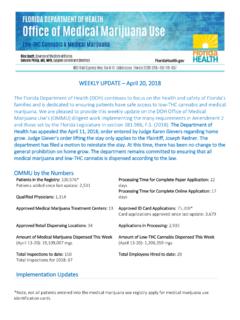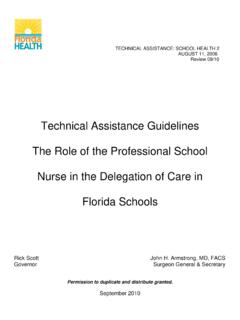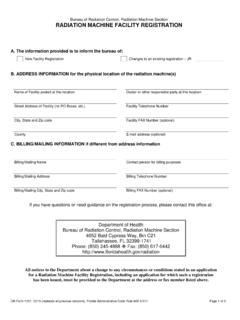Transcription of Statewide Drug Policy Advisory Council 2016 Annual Report
1 Statewide drug Policy Advisory Council 2016 Annual Report December 1, 2016 Rick Scott Governor Celeste Philip, MD, MPH Surgeon General and Secretary Contents Statewide drug Policy Advisory Council .. 3 EXECUTIVE SUMMARY .. 4 COSTS AND CONSEQUENCES OF NONMEDICAL OPIOID USE IN florida .. 5 EFFECTIVE RESPONSES TO THE OPIOID EPIDEMIC .. 9 Safe Prescribing Practices: .. 9 Public Awareness: .. 9 Increase Access to Naloxone: .. 10 Improve care Coordination: .. 10 Strengthen florida s Good Samaritan Law: .. 11 Increase Access to Medication Assisted Treatment: .. 11 Implement Evidence-Based School and Family-Based Primary Prevention Programs: .. 12 RECOMMENDATIONS .. 12 3 | P a g e Statewide drug Policy Advisory Council MEMBERS AND DESIGNEES Department of health Surgeon General and Secretary Celeste Philip, MD, MPH, Chair Jennifer Bencie, MD, MSA Administrator / County health Officer florida Attorney General The Honorable Pam Bondi Andrew Benard Assistant Deputy Attorney General and Special Counsel Office of Planning and Budget Cynthia Kelly Mary Beth Vickers, Policy Coordinator florida Department of Law Enforcement Commissioner Rick Swearingen Mark Baker, Inspector Office of Statewide Intelligence Department of Children and Families Secretary Mike Carroll Jeffrey Cece, MS, CPM Office of Substance Abuse and Mental health Department of Corrections Secretary Julie L.
2 Jones Patrick Mahoney, Bureau Chief Transition and Substance Abuse Treatment Services Department of Education Commissioner Pam Stewart Angelia Rivers. Bureau Chief Family and Community Outreach florida Highway Safety and Motor Vehicles Terry Rhodes, Executive Director Colonel Gene Spaulding, Director Department of Juvenile Justice Secretary Christina K. Daly Gayla Sumner, PhD, Director Mental health and Substance Abuse Services Department of Military Affairs Major General Michael A. Calhoun Colonel John Pelleriti, Special Forces florida Senate The Honorable Eleanor Sobel florida House of Representatives The Honorable Cary Pigman Supreme Court Appointee Judiciary Member Judge Melanie May Aaron Gerson Governor Appointee Mark P. Fontaine, Executive Director florida Alcohol and drug Abuse Association Governor Appointee Kimberly K. Spence, CEO Keaton Corrections Governor Appointee Peggy Sapp, President, CEO Informed Families Governor Appointee John VanDelinder, PhD.
3 , Executive Director Sunshine State Association of Christian Schools Governor Appointee Dottie Groover Skipper Salvation Army Governor Appointee Doug Leonardo, LCSW Executive Director BayCare Behavioral health Governor Appointee Roaya Tyson, COO Gracepoint 4 | P a g e EXECUTIVE SUMMARY As the State Surgeon General and Secretary for the florida Department of health , it gives me great pleasure to present florida s Statewide drug Policy Advisory Council s 2016 Annual Report required by section (4)(b), florida Statutes. The Report highlights this year s accomplishments by comprehensively analyzing the problems of substance abuse in the state and makes recommendations to the Governor and Legislature for the implementation of a state drug control strategy. The Council exemplifies the Department s mission to protect, promote and improve the health of all people in florida through integrated state, county and community efforts.
4 During the course of the year, the Council held three meetings in Tallahassee and two conference calls, hearing testimony from experts in the fields of addiction, drug abuse prevention, substance abuse treatment and agency initiatives. The meetings were held: January 29, 2016 March 11, 2016- conference call May 5, 2016 August 25, 2016 October 28, 2016- conference call On March 11, 2016, the Council adopted seven objectives to address the problem areas previously identified in its call to action. The seven objectives were assigned to various agencies for analysis and critique and include: 1. Develop a comprehensive repository of meaningful data and resources related to substance abuse. 2. Develop a process to integrate resources across state agencies to create the biggest impact on substance abuse issues in florida . 3. Develop a process to research, identify and share best practices from across the nation.
5 4. Develop an early warning network focused on supply reduction for emerging substances. 5. Provide recommendations to maximize existing resources. 6. Remove barriers to evidence-based treatments. 7. Produce and communicate the action plan. While promising progress has been made, other concerning aspects of the opioid epidemic have emerged, such as increases in heroin and fentanyl-related deaths. Strong multidisciplinary collaboration is needed to address these challenges and to maintain our progress to reduce misuse and abuse in our great state. The Council proposes 12 recommendations this year focusing on areas to reduce the demand for drugs, reduce the supply of drugs, improve data collection and surveillance, broaden prevention efforts, and expand treatment options. No sustainable process to compile massive amounts of data and information, perform analysis and develop an evidence-based call to action.
6 Many diverse groups and disciplines working on substance abuse issues with no coordinating body. Insufficient treatment capacity. Restrictions which impact use of beneficial treatments. Lack of public knowledge and participation in preventing drug use and abuse. PROBLEM STATEMENT 5 | P a g e COSTS AND CONSEQUENCES OF NONMEDICAL OPIOID USE IN florida Since 2000, the rate of deaths from drug overdoses has increased 137 percent, including a 200 percent increase in the rate of overdose deaths involving opioids (opioid pain relievers and heroin). In florida , 1,967 deaths were caused by at least one opioid in 2014. This means that at least five lives per day are lost to opioid overdose in The number of deaths in 2014 caused by motor vehicle crashes (2,402) and firearms (2,375) were less than deaths caused by prescription drugs, illicit drugs and alcohol detected in 8,587 ,3 From 1999-2014, the national age-adjusted mortality rate for opioid drug overdoses (which includes heroin and pharmaceutical opioids) was per 100,000.
7 florida s rate of per 100,000 exceeds the national average. florida ranks 21st out of all 50 states and the District of Columbia on this measure. florida s rate almost tripled over this time span, increasing from per 100,000 in 1999 to per 100,000 in Total societal costs of prescription opioid abuse in the United States were estimated at $ billion in 2007 (with workplace costs accounting for 46 percent, health care costs accounting for 45 percent, and criminal justice costs accounting for 9 percent).5 Prescription opioid overdoses result in 830,652 years of potential life lost before age In 2011, there were 1,563 instances of newborns diagnosed with drug exposure in florida , a three-fold increase since 2007 and neonatal abstinence syndrome (NAS) is still widely believed to be an under reported problem. NAS is a postnatal drug withdrawal syndrome in newborns caused primarily by in utero exposure to opioids.
8 Between 2010 and 2015, the number of cases of NAS in florida have increased by 86 percent (from 1,336 to 2,487).7 In the United States, the incidence of NAS increased 383 percent during 2000 2012, and state Medicaid programs cover an estimated 80 percent of hospital charges for While the numbers of women in florida giving birth to drug exposed newborns is still thankfully few as a total percentage of pregnancies, NAS afflicted newborns impose disproportionately higher costs on our health and social service systems compared to healthy Over the past decade, the Annual prevalence of diagnosed opioid abuse more than doubled among both privately insured and florida Medicaid populations. Researchers compared opioid abuse patients and demographically matched controls using privately insured and florida Medicaid administrative claims data from 2003 to 2007. Opioid abuse patients and caregivers had greater resource use in both privately insured and florida Medicaid populations compared with controls.
9 Mean excess Annual cost per privately insured patient was $20,546. Mean excess cost per florida Medicaid patient was $15, The prescription drug abuse epidemic is fueled in part by a minority of prescribers who over-prescribe or otherwise deviate from standards of practice. Prescribers who deviate from accepted standards of practice or whose prescribing is unusual or uncharacteristic for their specialty are considered at-risk In florida , the top 10 percent of prescribers account for approximately 64 percent of all From 2003-2009, physicians who worked in pain clinics in florida were prescribing large quantities of opioid analgesics with little medical justification, along with benzodiazepines, and muscle relaxants. In 2010, 98 out of the top 100 physicians who dispensed the highest quantities of oxycodone were located in florida . In response, pain clinic regulations were 6 | P a g e enacted, law enforcement raids were conducted, and physician dispensing of schedule II or III drugs from their offices was banned.
10 Dispenser reporting to a newly created Prescription drug Monitoring Program (PDMP) was mandated and additional regulations on wholesale distributors were enacted. Research shows that the implementation of PDMP and pill mill regulations resulted in a modest decrease in opioid prescriptions, opioid volume, and mean morphine milligram equivalent (MME) per Figure 1 illustrates the percentage of patients with exposure to higher than 100 MME per day and the mean MMEs for patients receiving opioids. The percentage of people prescribed greater than or equal to 100 MME per day among those receiving prescription opioids decreased from percent in 4Q 2011 to percent in 2Q During the same period, the mean MME per day decreased by percent from MME in Q4 2011 to MME at the end of Q2 2016. Figure 1. The mean daily dosage per patient in morphine milligram equivalents (MMEs) (line) and the percentage of patients on opioids receiving a dosage >100 MMEs.









